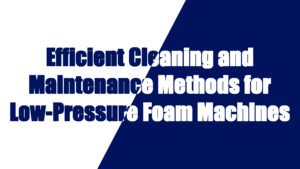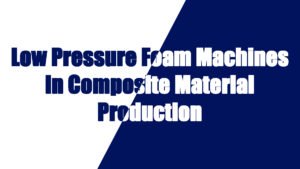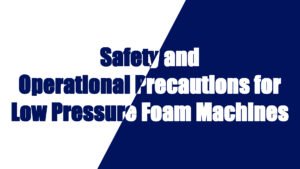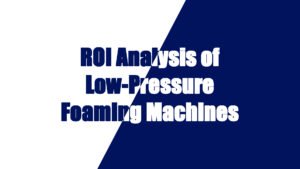Elastomers are widely used in industries such as automotive, industrial seals, medical devices, and consumer goods, with their market demand steadily increasing. Amid fierce market competition, improving production efficiency has become a priority for many manufacturers. This article provides a detailed discussion of strategies to enhance elastomer production efficiency, focusing on equipment upgrades, process optimization, and automation, with practical measures and case studies for reference.
1. Equipment Upgrades: Enhancing Core Competitiveness
1.1 Advanced Dynamic Mixing and Injection Technology
- Background: Traditional static mixing systems often suffer from low mixing efficiency and uneven material distribution, leading to quality issues and material waste. Dynamic mixing systems use rotational stirring for efficient and uniform material blending, greatly improving mixing quality.
- Practical Applications: Dynamic mixing systems allow real-time adjustment of ratios and mixing speeds to accommodate varying material properties, making them ideal for multi-variety, small-batch elastomer production.
- Results: Compared to traditional systems, dynamic mixers can reduce material waste by 15%-20% and significantly improve product consistency.
- Case Study: An automotive parts supplier implemented a dynamic mixing system, increasing hourly production from 50 to 65 units and improving raw material utilization by 18%, saving $25,000 annually.
1.2 High-Precision Temperature Control Systems
- Technical Principle: Elastomer production is highly sensitive to temperature variations. High-precision temperature control systems utilize zoned control and real-time sensors to maintain temperatures within ±0.1°C.
- Benefits: Improved temperature control reduces defect rates, enhances product performance, and increases customer satisfaction.
- Case Study: A medical device manufacturer adopted advanced temperature control systems, reducing scrap rates from 8% to 2% while lowering energy costs by 20%.
1.3 Multi-Function Equipment for Flexible Production
- Key Features: Multi-functional machines can handle diverse production needs without frequent component changes, significantly minimizing downtime. For example, transitioning between high-hardness elastomers and soft materials requires only parameter adjustments.
- Economic Impact: Multi-functional equipment supports multiple production lines, reducing capital investment and maintenance costs.
- Case Study: An industrial seal manufacturer reduced equipment changeover time from 4 hours to 45 minutes, boosting monthly output by 15% and decreasing manual errors.
2. Process Optimization: Unleashing Efficiency Potential
2.1 Raw Material Formulation Optimization
- Optimization Approach: Improving material ratios, selecting suitable catalysts, and adjusting fillers can significantly reduce curing times. For instance, rapid-curing formulations can shorten the liquid-to-solid transformation process by over 30%.
- Technical Advantage: Advanced material laboratories can simulate different production environments to determine optimal formulations.
- Data Insight: Studies show that optimized formulations can improve production efficiency by 15%-25% while reducing material waste by 3%-5%.
- Case Study: A shoe sole manufacturer introduced a new catalyst to reduce curing time from 12 minutes to 8 minutes, increasing monthly production by 1,000 units per line.
2.2 Mold Design and Cooling System Enhancements
- Design Improvements: Optimized mold flow channels ensure faster and more uniform material filling, reducing waste and defects.
- Cooling Efficiency: Cooling time is critical in elastomer production. Using high-conductivity mold materials or embedded cooling water channels can reduce cooling time by 30%-50%.
- Case Study: A home appliance parts manufacturer upgraded its cooling system, cutting cooling times from 5 minutes to 2 minutes, and improved production efficiency by 40%.
2.3 Standardization and Streamlined Processes
- Standardization Goal: Implement lean production principles to eliminate redundant steps and minimize resource waste. Standardized processes also shorten workers’ learning curves.
- Optimization Tools: Utilize value stream mapping (VSM) to identify production bottlenecks and optimize equipment layout.
- Case Study: An industrial seal manufacturer streamlined production processes, reducing batch production time by 20% and increasing equipment utilization from 70% to 85%.
3. Automation: Revolutionizing Production with Smart Systems
3.1 Intelligent Monitoring Systems
- Technical Features: Industrial IoT (IIoT) enables real-time monitoring of critical parameters such as pressure, temperature, and material flow, while predictive analytics identify potential failures.
- Impact: Intelligent monitoring reduces downtime by 20%-30% and enhances product consistency.
- Case Study: A large elastomer manufacturer deployed an IIoT-based monitoring system, halving equipment failure rates and saving $300,000 annually in maintenance costs.
3.2 Fully Automated Production Lines and Robots
- Key Benefits: Fully automated lines handle the entire production process, from raw material feeding to product molding. Robots in tasks like feeding, mixing, and injection provide high precision and efficiency.
- Economic Impact: Robots reduce dependency on manual labor and improve accuracy. Each robot can replace 3-5 workers, saving up to $100,000 annually.
- Case Study: An industrial seal producer introduced fully automated lines, increasing production efficiency by 30% and halving labor costs.
3.3 Intelligent Scheduling and Resource Optimization
- Implementation: Enterprise Resource Planning (ERP) systems dynamically adjust production schedules, ensuring optimal resource utilization at each stage.
- Case Study: A manufacturer using intelligent scheduling reduced order lead times by 50% and achieved a 95% equipment utilization rate.
4. Market Trends and Future Prospects
4.1 Rising Global Demand Drives Efficiency Enhancements
Market data indicates that the global elastomer market is expected to grow at a compound annual growth rate (CAGR) of 6.8% over the next five years. This growth fuels the need for efficient production solutions.
4.2 Innovations Shaping the Future
- New Materials: The development of eco-friendly raw materials is driving the demand for flexible, high-efficiency equipment.
- Artificial Intelligence: AI-powered elastomer production equipment will optimize the entire process, from design to production.
4.3 Sustainability Trends
- Green Manufacturing: Energy-saving policies are pushing companies to adopt efficient, low-emission equipment to reduce their carbon footprint.
- Forecast: By 2030, over 80% of companies in the industry are expected to use energy-efficient equipment.
Improving elastomer production efficiency requires a multi-faceted approach, combining equipment upgrades, process optimization, and automation technologies. By leveraging advanced systems and intelligent solutions, manufacturers can reduce costs, enhance productivity, and strengthen their competitive edge. With growing global demand and evolving technologies, the elastomer production industry is poised for transformative growth.




































